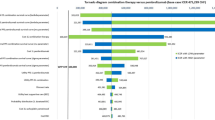Summary
Polychemotherapy is the therapeutic option recommended for nonresectable, non-small cell lung cancer (NSCLC). However, the modest gains in survival, and the frequent and often serious adverse effects, associated with chemotherapy should also be considered when deciding on therapy. We therefore performed a cost-utility analysis of chemotherapy and best supportive care in NSCLC. Effectiveness and costs were analysed on 70 patients who were randomised to receive one of 3 treatments: VP (vindesine and cisplatin), CAP (cyclophosphamide, doxorubicin and cisplatin), or best supportive care. Subsequently, an assessment of the value of polychemotherapy and best supportive care was performed by oncology personnel using the time trade-off technique. Polychemotherapy was found to be more effective than best supportive care, but was also more costly and had a lower value score. Because of its cost utility and its higher value, best supportive care should not be discarded as an alternative for the treatment of NSCLC.
Similar content being viewed by others
References
Boring CC, Squires TS, Tong T. Cancer statistics. 1992. CA Cancer J Clin 1992; 42: 19–39
Belani CP, Aisner J. Combined-modality therapies for non-small cell lung cancer. Ann Oncol 1992; 3 Suppl. 3: S3–10
Souquet PJ, Chauvin F, Biossel JP, et al. Polychemotherapy in advanced non small cell lung cancer: a meta-analysis. Lancet 1993; 342: 19–21
Klastersky J. Faut-il traiter les cancers pulmonaires inoperables? Rev Med Brux 1993; 14 (4): 102–9
Evans WK. Management of metastatic non-small cell lung cancer and a consideration of cost. Chest 1993; 103 (1 Suppl.): 68S-71S
Rapp E, Pater JL, Willan A, et al. Chemotherapy can prolong survival in patients with advanced non-small-cell lung cancer: report of a Canadian multicenter randomized trial. J Clin Oncol 1988; 6: 633–41
Drummond MF, Stoddard GL, Torrance GW. Methods for the economic evaluation of health care programmes. Oxford: Oxford University Press, 1987
Torrance GW, Sackett TWH. A utility maximization model for evaluation of health care programs. Health Serv Res 1972; 7: 118–33
Furlong W. Feeny D. Torrance GW. et al. Guide to design and development of health-state utility instrumentation. CHEPA working paper series. #90–9. Hamilton (Ont.): McMaster University, 1990
Contandriopoulos A-P, Champagne F, Tessier G, et al. Analyse coût-efficacité de la chimiothérapie dans Ie traitement du cancer du poumon metastatique non-à-petites-cellules. Montréal: University of Montréal Publications du GRIS, R90–02, 1990
Palmer MJ, O’Sullivan B, Steele R, et al. Controversies in the management of non-small cell lung cancer: the results of an expert surrogate study. Radiother Oncol 1990; 19: 17–28
Jaakkimainen L, Goudwin PJ, Pater J, et al. Counting the costs of chemotherapy in a National Cancer Institute of Canada randomised trial in non small-cell lung cancer. J Clin Oncol 1990; 8 (8): 1301–9
Fernandez C, Rossell R, Abad-Esteve A, et al. Quality of life during chemotherapy in non-small cell lung cancer patients. Acta Oncol 1989; 28: 29–33
Maasilta PK, Rautonen JK, Mattson MT, et al. Quality of life assessment during chemotherapy for non-small cell lung cancer. Eur J Cancer 1990; 26: 706–8
Degner LF, Sloan JA. Decision-making during serious illness: what role do patients really want to play? J Clin Epidemiol 1992; 45 (9): 941–50
O’Connor AM. Effects of framing and level of probability on patients’ preferences for cancer chemotherapy. J Clin Epidemiol 1989; 42 (2): 119–26
Sutherland HJ, Llewellyn-Thomas HA, Lockwood GA, et al. Cancer patients: their desire for information and participation in treatment decisions. J R Soc Med 1989; 82: 260–3
Stiggelbout AM, Kiebert GM, Kievit J, et al. Utility assessment in cancer patients: adjustment of time trade-off scores for the utility of life-years and comparison with standard gamble. Med Decis Making 1994; 14 (1): 82–90
O’Connor AMC, Boyd NF, Warde P, et al. Eliciting preferences for alternative drug therapies in oncology: influence of treatment outcome description, elicitation technique and treatment experience on preferences. J Chron Dis 1987; 40 (8): 811–8
Author information
Authors and Affiliations
Rights and permissions
About this article
Cite this article
Kennedy, W., Reinharz, D., Tessier, G. et al. Cost Utility of Chemotherapy and Best Supportive Care in Non-Small Cell Lung Cancer. Pharmacoeconomics 8, 316–323 (1995). https://doi.org/10.2165/00019053-199508040-00006
Published:
Issue Date:
DOI: https://doi.org/10.2165/00019053-199508040-00006




